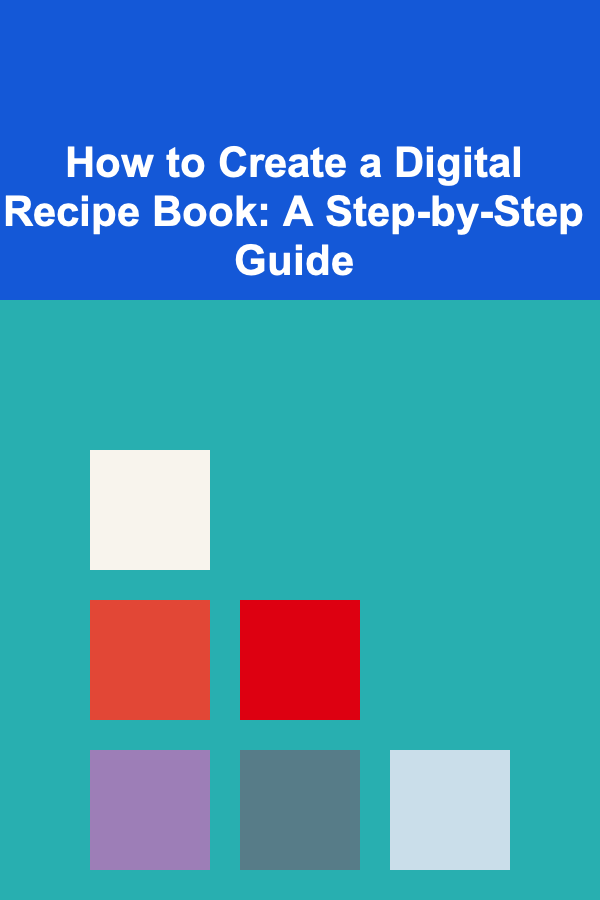
How to Create a Digital Recipe Book: A Step-by-Step Guide
ebook include PDF & Audio bundle (Micro Guide)
$12.99$5.99
Limited Time Offer! Order within the next:

In today's fast-paced world, where technology is deeply integrated into our daily lives, creating a digital recipe book has become a practical and efficient way to organize and share your culinary creations. Whether you're a seasoned chef, an amateur cook, or someone who simply loves experimenting with food, a digital recipe book provides the flexibility, accessibility, and customization that traditional cookbooks can't. This guide will walk you through everything you need to know to create a comprehensive, visually appealing, and user-friendly digital recipe book.
Planning Your Digital Recipe Book
1.1 Define Your Goal
The first step in creating a digital recipe book is to define its purpose. Ask yourself:
- Who is the target audience? Are you creating the recipe book for personal use, to share with friends and family, or to sell it commercially?
- What type of recipes do you want to include? Are you focusing on a specific cuisine (e.g., Italian, vegan, desserts), or are you including a broad range of recipes?
- How will your book be used? Will it be used in the kitchen for quick reference, or is it more of a collection to share and inspire others?
By understanding the purpose of your recipe book, you'll be able to tailor its content, design, and structure to suit your needs.
1.2 Organize Your Recipes
An essential step in creating a digital recipe book is organizing your recipes. This not only makes it easier to navigate the book but also helps create a more cohesive reading experience. There are several ways to categorize your recipes:
- By Course: Breakfast, lunch, dinner, appetizers, snacks, desserts, etc.
- By Cuisine: Italian, Asian, Mediterranean, etc.
- By Dietary Preference: Vegan, gluten-free, keto, paleo, etc.
- By Ingredients: Recipes using a specific ingredient like chicken, eggs, or vegetables.
Once you've decided on categories, start compiling your recipes in a list or spreadsheet. This can be helpful when it comes time to format your book.
1.3 Choose a Digital Format
The format you choose for your digital recipe book is crucial for both design and functionality. Here are the most common formats:
- PDF: Portable Document Format (PDF) is one of the most widely used formats for digital recipe books. It's ideal for high-quality printouts and can be easily shared across different devices.
- ePub: ePub is a popular format for eBooks, ideal for reading on eReaders such as Kindle and iPads. It allows for a more flexible and reflowable layout, making it easier for readers to adjust text sizes.
- Website or Blog: If you're looking to create a dynamic, easily updated recipe book, consider building a website or blog. This format allows you to update recipes frequently and incorporate multimedia content like videos and photos.
Each format has its own advantages, and the right choice depends on how you envision using your recipe book.
Designing Your Digital Recipe Book
2.1 Choose a Design Platform
The next step is to select a design platform. There are several options for designing your recipe book, depending on your skill level and desired output:
- Canva: Canva is a user-friendly graphic design tool that offers a wide range of templates for recipe books. You can drag and drop images, text, and other elements, making it perfect for beginners.
- Adobe InDesign: Adobe InDesign is a professional desktop publishing software that's perfect for creating detailed, high-quality recipe books. It allows for precise control over layout, fonts, and images, but it has a steeper learning curve.
- Microsoft Word or Google Docs: If you're looking for a simpler approach, using word processing software can be effective. While less customizable than graphic design tools, it still allows you to create a clean, readable layout.
- Book Creator or Blurb: These platforms allow you to create eBooks specifically and have templates designed for cookbook creation.
Regardless of the platform you choose, ensure that it allows you to export your work in a format like PDF or ePub for easy sharing and publishing.
2.2 Visual Elements
Visuals are a key aspect of a recipe book, as they help break up text and make the book more appealing. Here's how you can use visuals effectively:
- Photographs: High-quality food photography is essential to making your recipes look tempting. Take clear, bright photos that highlight the finished dish. Consider including step-by-step photos for more complex recipes.
- Illustrations: You can also use illustrations, especially if your recipe book has a playful or artistic vibe. Custom illustrations can help distinguish your book from others.
- Typography: Choose legible fonts that are easy to read on both desktops and mobile devices. Keep the font size appropriate for both headings and body text.
- Color Scheme: Select a color palette that reflects your brand or the theme of your book. Soft, neutral tones work well for clean, minimalist designs, while vibrant colors can add excitement to a more casual, fun cookbook.
2.3 Layout and Structure
Consistency in layout is key to creating a professional-looking recipe book. Here are some tips for layout and structure:
- Headers and Subheaders: Use consistent headers for each recipe. For example, each recipe should start with the recipe name, followed by the preparation time, ingredients, and instructions.
- Recipe Cards: Consider using recipe cards, which allow you to separate each recipe from others visually. This makes the book easy to navigate.
- Spacing: Use adequate white space between sections to avoid a cluttered look. This will make the book more readable and user-friendly.
- Interactive Elements: If you're creating a digital recipe book in a PDF or website format, you can add interactive elements such as hyperlinks (to other recipes), embedded videos, or pop-up windows.
Writing and Formatting Recipes
3.1 Recipe Structure
Each recipe should follow a clear and consistent structure to make it easy for the reader to follow. Here's a basic outline for each recipe:
- Recipe Title: A descriptive name for your dish.
- Introduction: A short description of the dish, its origin, or why it's a favorite. This could also include any interesting tips or variations.
- Ingredients List: Organize ingredients by category (e.g., dry ingredients, wet ingredients). Include exact measurements, and be sure to list special instructions for specific ingredients.
- Preparation Instructions: Step-by-step instructions on how to prepare the dish. Be clear and concise, and consider using bullet points or numbered lists for easy readability.
- Cooking Time and Servings: Include estimated cooking time and the number of servings each recipe yields.
- Additional Notes: Any helpful tips, storage advice, or substitutions for ingredients.
3.2 Maintain Consistency
Consistency is key in recipe formatting. Make sure that each recipe follows the same layout and uses the same font, size, and style for headings and instructions. This will help maintain a uniform reading experience for your audience.
Adding Extra Features
4.1 Index and Searchability
A useful feature of digital recipe books is the ability to search for specific recipes or ingredients. If you're creating a PDF or an eBook, consider adding a clickable index or a table of contents with hyperlinks to specific sections of the book. This makes it easier for readers to find what they're looking for quickly.
4.2 Printable Shopping Lists
Including printable shopping lists for each recipe can be a helpful addition. You could provide a downloadable PDF or interactive list that readers can print or share with others.
4.3 Interactive Features
For an even more engaging experience, consider adding interactive features such as:
- Videos: Short cooking videos or tutorials embedded within the book to demonstrate tricky cooking techniques.
- Audio: You can add audio instructions for people who prefer to listen rather than read.
- Meal Planning Tools: Some digital recipe books include weekly meal planning features or calendar integration to help readers organize their cooking schedule.
Publishing and Sharing Your Digital Recipe Book
5.1 Choose a Publishing Platform
Once your recipe book is complete, it's time to publish it. There are several platforms you can use depending on your format:
- For PDFs and eBooks : You can sell or distribute your digital recipe book through platforms like Amazon Kindle Direct Publishing (KDP) , Apple Books , or Gumroad.
- For Websites or Blogs: If you're hosting your recipe book on a website or blog, make sure it's optimized for both desktop and mobile use. You can monetize your site by offering a paid subscription, ad space, or premium recipes.
- Social Media: Use platforms like Instagram, Pinterest, or Facebook to share your recipes and drive traffic to your digital cookbook.
5.2 Promote Your Recipe Book
To attract readers, you'll need to promote your digital recipe book. Here are some strategies:
- Social Media: Share sneak peeks of your recipes, behind-the-scenes content, and tips on social media platforms to build excitement.
- Email Marketing: Collect email addresses from potential readers and send them a sneak peek, exclusive recipes, or discounts.
- Collaborations: Collaborate with food bloggers or influencers to promote your recipe book to a larger audience.
Conclusion
Creating a digital recipe book is an exciting and rewarding project that allows you to share your love of cooking with others while leveraging the power of technology. By following these steps---planning your content, designing an appealing layout, writing consistent recipes, and publishing on the right platform---you'll have a cookbook that not only looks great but is easy to navigate and use. Whether you're sharing family recipes, promoting a healthy lifestyle, or showcasing your culinary expertise, a digital recipe book is a fantastic way to spread the joy of food to the world.

How to Balance Saving for the Future and Enjoying Life Today
Read More
How To Limit Data Collection in Physical Stores
Read More
How to Manage Your Student Loan Debt Efficiently
Read More
How to Save Space in a Small Bathroom with Floating Shelves
Read More
How to Use Clear Containers for Craft Supply Visibility
Read More
10 Tips for Creating a New Year's Resolution To-Do List You'll Actually Stick To
Read MoreOther Products

How to Balance Saving for the Future and Enjoying Life Today
Read More
How To Limit Data Collection in Physical Stores
Read More
How to Manage Your Student Loan Debt Efficiently
Read More
How to Save Space in a Small Bathroom with Floating Shelves
Read More
How to Use Clear Containers for Craft Supply Visibility
Read More